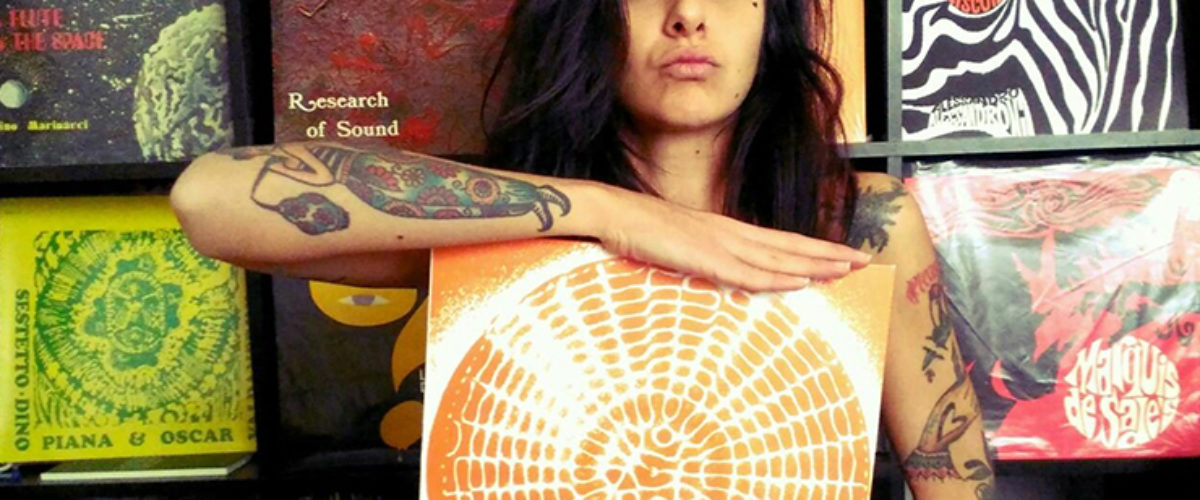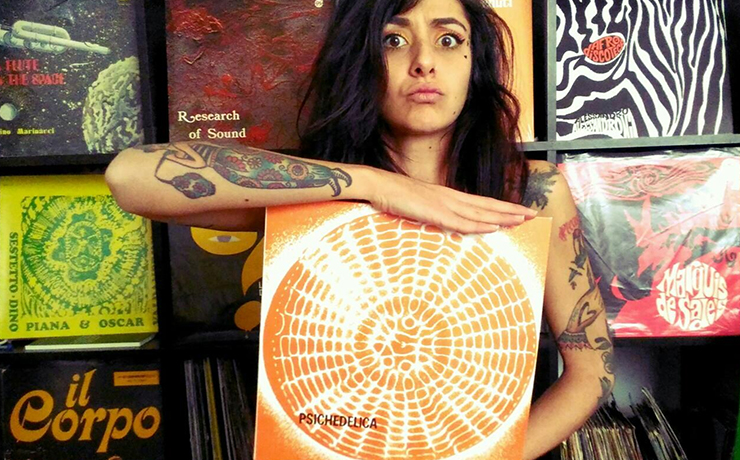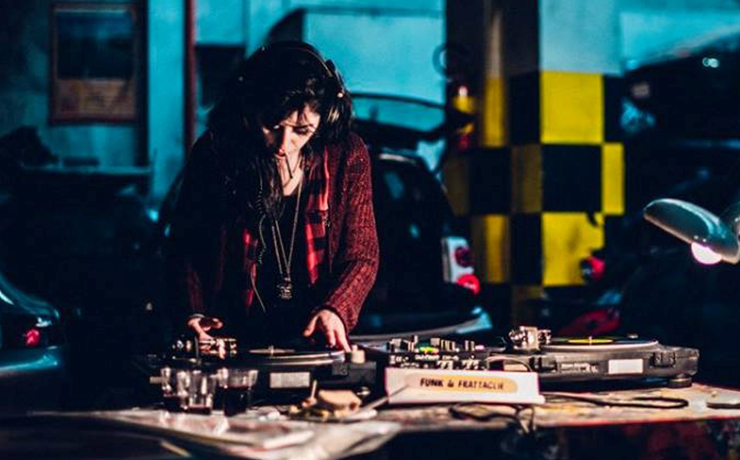

Have you ever heard about libraries and background music?
If you haven’t, maybe it’s the case for you to read. If you haven’t, just go ahead and you’ll know more. Because, for your info, for this new Wood’d Vibes we’ve thought to take you to a different ride. We’ve thought to push us into the rare, more refined groove. We’ve been thinking of calling a young lady who, in the case of rare records, is one who knows what she is doing. We called Letizia, and got answered by LA Ponto. We ended up talking about libraries, inevitably, and having a mix that smells like what we like, and we hope you’ll like it too. See ya!
Ciao Letime aka LA aka LA Ponto! Would you like to introduce yourself to our friends?
Ciao Uncovered and ciao everybody, let’s keep it short: my name is LA Ponto, biochemist by day, dj at night, playing sounds and shuffling through music for almost 30 years now. For the most part of my life I’ve lived in the southern part of Italy, between the infamous SS106 and Catania. But now for a while I am stable in Florence between Renaissance, discs and humidity.
Simple, classic, but necessary question, a rite almost: how it started everything?
It started by chance, or maybe it was just the natural evolution of my approach to music, as I was born among records. It took me a while before buying on my own, and it took even more before I found myself in console deejaying. My parents often tell me how I was jumping to the slightest hint of rhythm while my mother was pregnant with me, they always loved black music, and they carried me around to see concerts since my early days. First one was Ray Charles, and I was less than a year old, then Umbria Jazz, and so on. Dad always bought records, so vinyl was the first and main source to me since back in the days. That’s how I learned to listen to music. To me, however, dad’s hundreds of long-playing records were never enough. I used to to compel him to record for me a variety of his stuff on audio cassettes, for instance. But not only. I did tapes also off the radio, spent afternoons dancing in front of music videos on TV, while I imprinted them on a couple of VHSs, and recycled these whenever they were filled.
In early 2000 there was a “turnaround”, which was the beginning of a musical path still evolving and, hopefully, unstoppable. This was around the time I discovered the Italian libraries. At the age of 13, don’t even ask how, I found a few compilations in my hands, and entered a wonderful world. For the very first time, I suddenly came to see Italian music as I ever thought of it. Until that time, the sound of the Belpaese was limited to the San Remo, and related TV marathons with my grandmother. Or Festival Bar, and a few songs from Loredana Berté. Finding something that I used to hear in overseas songs seemed like incredible, so I started looking for informations about these gentlemen who composed such music. Name’s were Umiliani, Piccioni, Trovajoli: I didn’t have any idea about who they were and what they were doing. I trusted the acquaintances of some of my biggest friends, I started looking on net forums and primordial blogs. I’ve spent hours on regional channels hoping to find some screening of seminal films, in spasmodic search of clues and more music. Just to discover, over 10 years later, that, on the Riviera of Romagna, a whole scene revived and revalued the world I was beginning to face. Up to this day, with some of the protagonists of that time, we have become friends, and I jealously keep anecdotes and musical pearls that they have given me, and helped me to gravitate with knowledge of cause in this vast universe.
However, in parallel with libraries, there has always been funk, jazz and blues and, to combine it all, my uncontrollable need to divulge the stuff I had in my ears. With musical stalking to my friends and whatever media allowed me to do so. The real digging has just arrived at the age of 20, a little before my debut as a deejay, with the first salary and the first flea markets in Sicily. These kinda further inflated the compulsive need to accumulate new and unknown music. I started buying a shitty turntable, and spending every Sunday morning dropping my savings in horrible and ruined records, between stalls and rubbish. I had also a bracket of compulsive purchases (stocks included) on the internet, but nowI’m cured, it just happens that I occasionally take notice of something interesting on the web, but those are exceptional cases nowadays. In Florence there are good record stores, and many markets too, so personally I still prefer to dirt my hands, even at the risking of going back home with nothing. I always liked to fulfill my deejay bag helped by the case, following a feeling in flea markets, because this way I can tell a better story as a deejay. Those casualties improve me and make it all the more fun.

Since you mentioned it above, what can you say about the sonorization and, in general, the world to these bonds? What are they and why do they like it?
The term “sonorizations”, or “libraries”, it refers to all that music originally conceived as a background for movies, TVs, documentaries and radio transmissions. In fact, the term hides masterpieces ranging from jazz to proto-electronic music, all material far removed from what had been regarded as “commercial” in the 1960s and 1970s by tv stations and broadcasters. Typically European phenomenon, the library music was a bit of the escamotage of many musicians to be able to express themselves freely despite market demands. So, to answer the constant demand for programming material, many independent labels, or subheadings of bigger staples, dedicated themselves to the production of synchronization material. In Italy we had Canopo, Nike, Lupus, or the most popular Omicron, Cinevox, Cam, among many others. Currently, libraries are also confused with other recordings that do not retain the typical original format (pieces are not too long, covers with the added duration and descriptive comments on the various tracks, alternate versions of the same piece) I think of records like Under Pompelmo , Psycheground Group , Jazz now in Italy .
The original records are particularly hard to find, sometimes unavailable, or in miserable conditions and with out-of-the-box prices, so simple amateurs become rarity collectors in a second. Luckily, there are many current reprints thanks to the work of recuperation made in recent years by several labels (Four Flies Record, Sonor Music, Schema, Comet and old timers like Right Time and Dejavu), given the growing interest in genres by a new audience. Thus they have the opportunity to restore the splendor of some masterpieces still in the forgotten, or even yet to be discovered. The experience and the passion of some of those artisans have indeed created a kind of “musical archaeological movement”. They shed a light which light even on unpublished and unknown works. I think for instance to the soundtrack of Sortilegio, a movie whose original film has been lost, but the master of the soundtrack has been found recently, and printed on vinyl for the first time.

What you would suggest to those who would like to start digging in the crates?
To go dig for records with passion and lightheartedness, focusing more on content than on the support. I always thought that you should buy what you like and not what “you have to have“, the dig as a game of action figures is not for me. I have never had fun with it, and maybe that’s why I do not really consider myself as a “collector”.
What are you currently listening to in background?
“C’è un fantasma nel mio letto – M68” from Studio Umiliani, a superb compilation full of previously unreleased material from back in the days. It has been recently released and it’s fundamental to all Piero Umiliani fans!
Last but fundamental question: what you have cooked for Wood’d?
The idea of translating wood in music, making it sound like so, has had me tripping a lot, before recording the actual mix I’ve spent days listening to hours and hours of music. I realized I had two perceptions of the concept of wood: on one hand, purely as a natural element. So warm, tidy, scented, with that sense of comfort that can give you a nice room with parquet and wooden beams, maybe a little minimalist or with a nice fireplace. On the other hand, the “woody” in its etymological sense: dry, fibrous, knotty, braided, robust, sharp, secular, heavy. Something that in music takes on a positive connotation, and describes a large part of the nuances of sound that usually make me sick. There was a selection of about forty minutes, pure Ponto style. For your joy, to each song I have also associated the name of a particular wood, which can help describing my mechanical and sensory vision… yes, ok… I am redundant, I know, it sounds like a library concept mix, but it’s a deformation…I hope you like it!?
1- Rosewood (Giulio Sorgini- Ultima Caccia)
2- Balm (Lesiman- Messaggio)
3- Acacia (The Tropicals – African popcorn)
4- Boxwood (Luigi Zito – Bossa Astratta)
5- Tek (Dorothy Ashby – Moving Finger)
6- Chestnut (The Mohawks – Landscape)
7- Oakwood (Groover Holmes – Red onion)
8- Linden (Luis Bacalov – Nago)
9- Cedar (Chackachas – Jungle fever)
10- Mahogany ( Jimmy Smith – Get out of my life woman)
11- Plane (Fela Kuti e Ginger Baker – Ye Ye smell)
12- Ebony (Nina Simone – Funkier than a mosquito tweeter)
